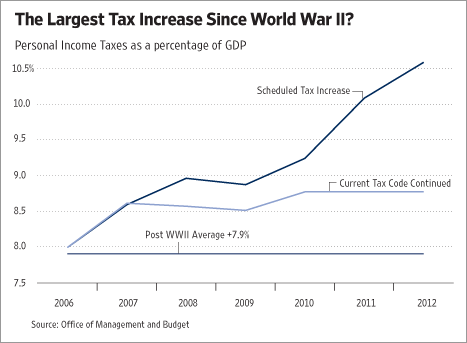Sorry about that; I accidentally hit “Publish” way before I was ready.
(H/T – Flip)
While the old OpinionJournal may be dead, I do appreciate the fact that the entire The Wall Street Journal editorial page is free to all. In today’s edition, John Cogan and Glenn Hubbard peer into the future of the bite of the individual income tax.
First, let me steal what Flip rightfully called “The Ugliest Chart You’ll See All Day”, which estimates the percentage of Gross Domestic Product taken by the federal government over the last 2 years and next 5 years through the individual income tax structure…

…and make some uglier observations. First, note that the divergence between the code as it existed at the end of 2007 and as it did at the end of 2000 actually begins this year. I don’t have the time to research just what parts of the Bush tax-rate cuts of 2001 and 2003 expired already, but some of them already have. Since one can’t expect a Congress controlled by Democrats to give so much as a 1-year extension to tax-rate cuts both of their candidates are committed to eliminating entirely, the divergence should actually begin at 2009. Further, one can’t simply move the “current tax code” line up to meet that; those same Dems as well as select Republicans (including their Presidential nominee) cannot be expected to restore those tax-rate cuts that are already expired, so even if the remainder of the tax-rate cuts were to survive, the individual income tax would likely take something north of 9.3 cents of every dollar produced by the economy, compared to 8 cents in 2006 and an estimated 8.6 cents in 2007.
Even the focus on the indivudal income tax, while historic in its rise under the time bomb the Democrats are intent on setting off, is misleading. While it is the largest single component of the federal government’s drag on the economy, it is far from the only one. The total federal drag on the economy, euphemistically called “federal revenues”, is 18.8% of GDP. While Cogan and Hubbard focused solely on the individual income tax increases in store from the Democrats when they said that either Barack Obama’s or Hillary Clinton’s plans would result in the feds taking 20% of the GDP, the amount that they would have the goverment take will be higher than that as “corporate” income taxes will also be jacked up at astronomical rates. I may not be an economist, but I’ll lay what’s in my wallet against what’s in their wallets in saying that the federal government’s total drag on the economy will be closer to 25% of GDP by 2012 than 20% of GDP.
That reminds me of something my Congressman, Paul Ryan (R) has been saying lately. By the time his children are his age (roughly 2040), if there is no increase beyond inflation in discretionary spending and no changes in the welfare programs (misnamed “mandatory spending”), the federal government would be taking 40% of GDP. For those that didn’t do the math, that’s double the tax burden just to keep the current level of government we have now, and that doubling is on top of historically-high taxes.
I honestly could go on all day with the rest of the opinion piece, but I do want you to read it.
As our economic model i.e. lower population growth and higher social services, looks more and more like the European model, we are surprised that our funding requirements also will look more and more like the European model? Silly Rabbit, Taxes are for keeps!
Another thought….I can’t recall who said it but it was prescient of our current situation. The comment was bascially that once 50% of the population figured out that they could control what the rest of the population pays or contributes in taxes, the Capitalism system collapses. That is a point that we are quickly approaching.
I should recall who said that, as I quote it enough. Depending on the metric, we’ve already crossed that point, or we’re about to cross it. If nothing substantive is done, we will undoubtedly be across it by 2012; unfortunately, even McCain won’t do anything substantive.
In practice, it’s not exactly 50% of the population, but 50% of those that care enough to vote. That’s both a blessing and a curse, but the expansion on that thought is really something for its own post.
Agreed, in fact I was just having a conversation about broader economic issues and the point was made that the subprime swirl and it’s ripple are nearly irrelevant if we don’t fix the fact that we are the world’s largest debtor. Like the folks who have the subprime loans, our options will run out once our monthly payment on the debt exceeds our discretionary income…that point is too quickly approaching.
Excellent post.. I swiped the chart with a link back here for the splainin….